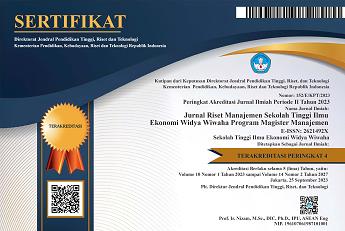PENGARUH LINTAS BUDAYA PADA PEMASARAN INTERNASIONAL DENGAN PENDEKATAN PERILAKU KONSUMEN
DOI:
https://doi.org/10.32477/jrm.v1i2.113Keywords:
cross culture, globalization, marketing strategy, culture orientationAbstract
In this article we present a conceptual of the effect of cross culture on consumer behavior incorporating the impact of globalization. This conceptual idea shows that culture inûuences various domains of consumer behavior directly as well as through international organization to implement marketing strategy. The conceptual identify several factors such as norm and value in the community, several variables and also depicts the impact of other environmental factors and marketing strategy elements on consumer behavior. We also identify categories of consumer culture orientation resulting from globalization. Highlights of each of the several other articles included in this special issue in Asia region. We conclude with the contributions of the articles in terms of the consumer cultural orientations and identify directions for future research.
References
Boucher, H. C. (2005), Culture and Implicit Self- Concept Inconsistency, A Dissertation in Psychology, University Of California, Berkeley.
Cherrier, H. (2009), The Globalizing Arab World: Impacts On Consumers’ Level Of Materialism And Vanity, Working Paper 09 – 003, The American University in Dubai.
Choi, J. (2001), ”A Cross-Cultural Investigation Of Consumer E-Shopping Adoption: A Comparison Of Korean And American College Student”, The Ohio State University, UMI Dissertation Publishing, 3031186.
Cornwell, T. B. and Drennan, J. (2004), “Cross- Cultural Consumer/Consumption Research: Dealing with Issues Emerging from Globalization and Fragmentation”, Journal of Macromarketing, 24, 108.
Dodson, K.J. (2001), “The Impact Of Cultural Dissonance On Corporate Strategy And New Product Development: An Ethnography Of High-Tech Corporate Start-Up”, The University of Utah, Proquest, UMI Dissertations Publishing, 3032059.
Galperin, H. (1999), “Cultural industries in the age of free-trade agreements”, Canadian Journal of Communication, 24.1, 49-77.
Gereffi, G. (2001), ”Shifting Governance Structures In Global Commodity Chains,With Special Reference To The Internet”, American Behavioral Scientist, Vol. 44, 10, 1616- 1637.
Gough, D.C. (2006), “Mobility, Tradition And Adaptation: Samoa’s Comparative Advantage In The Global Market Place”, Graduate Journal Of Asia-Pacific Studies, 4:1, 31-43.
Hise, R. and Choi, Y.T. (2011), ”Are Us Companies Employing Standardization Or Adaptation Strategies In Their International Markets?” Journal of International Business and Cultural Studies, 4, 1-29.
Hughes, G.S. (1997), “Manufacturing Identity: Some Educational Insight Into English Canada’s National Self-Image”, UMI Dissertations Publishing, MQ24161.
Klinefelter, G. (2010), ”Management Across Cultures: Challenges and Strategies”, American Library Association dba CHOICE, 757732051
Kolodko, G.W. (2005), “ Globalization, Transition, and Development Prospects”, Finance India, Vol.19, 2, 465-479.
Lantz, G. (1998), ”The Country-Of-Origin Effect And Social Ident ity: The Ways An Individual’s National Identity Affects Product Preferences”, The University of Manitoba (Canada), UMI Dissertations Publishing, NQ32882.
Lee, C.A., Bang, H.Y., Ha, J.W., Lee, J.Y., and Kim, Y.H.Y. (2011), “An Analysis Of Cultural Impact On International Business Performance Via Foreign Market Entry Mode: Case Of South Korean MNc s” Journal of Management and Marketing Research, 7, 1-8.
Manrai, L.A. and Manrai A.K. (2011), ”Cross-National Consumer Research in the Global Economy of the Twenty-First Century,” Journal of International Consumer Marketing, 23, 167-180
Manrai L.A. and Manrai A.K. (2010),” Entrepreneurship and Development: Local Process and Global Patterns”, The Royal Institute of Technology, Centre of Excellence for Science and Innovation Studies (CESIS)
Moore, E.G. (1998), ”Competitive Judgement in a Business Simulation: A Comparison between American and Chinese Business Students”, Psychology & Marketing, Vol.15, 6, 547-562.
Moon, T.W. and Park, S.I. (2011), ”The Effect of Cultural Distance on International Marketing Strategy: A Comparison of Cultural Distance and Managerial Perception Measures,” Journal of Global Marketing, 24, 18- 40.
Rota, S.L.M. (2010), “PostColonialism vs. Globalization: Negotiating the ’Local’ “, Journal of Post-Colonial Cultures and Societies, Vol.1, 2, 5-21.
Singhapakdi, A., Rawwas, M.Y., Marta, J., and Ahmed, M.I. (1999), “A Cross-Cultural Study of Consumer Perception about Marketing Ethics”, The Journal of Consumer Marketing, Vol.16, 3, 257-272.
Sudarti, K. (2013), “Peningkatan Minat Pembelian Merek Lokal Melalui Consumer Ethnocentrism”,Jurnal.unimus.ac. id/ index.php/vadded/article/view/837.
Tian, K. and Borges, L. (2011), “Cross-Cultural Issues in Marketing Communications: An Anthropological Perspective of International Business”, International Journal of China Marketing , Vol. 2, 1.
Ulgado, F. M. and Lee, M. (1998),” The Korean versus American Marketplace: Consumer Reactions to Foreign Products”, Psychology & Marketing (1986-1998); Vol.15 ,6 , 595.
Vrontis, D. and Kitchen, Philip J. (2005),”Entry Methods And International Marketing Decision Making: An Empirical Investigation”, International Journal of Business Studies, Vol. 13, 1, 87-110.
Yi, Youjae. (1998), ”Marketing in East Asia: A Cross-Cultural Perspective” Psychology & Marketing, Vol. 15, 6, 503









